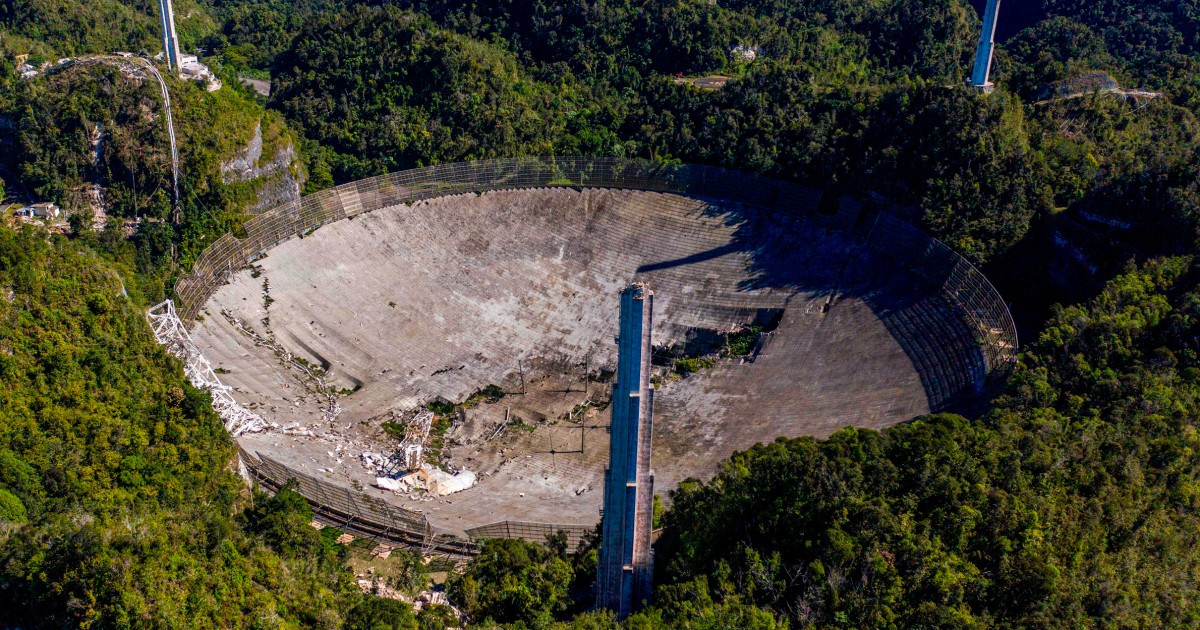Four years after the radio telescope at the Arecibo Observatory in Puerto Rico collapsed, a report from the National Academies of Sciences, Engineering and Medicine is shining a light on the unprecedented failures that caused its destruction.
The steel cables holding up the telescope’s 900-ton receiver platform became loose because the zinc-filled sockets built to support them failed, according to the report published Oct. 25.
The failure was due to excessive “zinc creep,” a process in which the metal used to prevent corrosion or rusting on the sockets deforms and loses it grip over time, the report said.
The zinc gradually lost its hold on the cables suspending the telescope’s main platform over the reflector dish. This allowed several cables to pull out of the sockets, ultimately causing the platform to plummet into the reflector more than 400 feet below, according to the report.
This kind of failure “had never been reported previously in over a century of widespread zinc spelter socket successful use,” Roger L. McCarthy, chair of the committee on the analysis of causes of failure and collapse of the 305-meter telescope at the Arecibo Observatory, wrote in the report.
The committee, which wrote the report said there was not enough data available to conclusively prove what exactly caused the accelerated “zinc creep.” The only hypothesis the committee was able to develop based on the data it had put the blame on the effects of low-current electroplasticity. In other words, the constant flow of electric current through the sockets may have enhanced the metal zinc’s plastic behavior, therefore weakening its grip.
The committee reviewed an array of documents — including forensic investigations commissioned by the University of Central Florida and the National Science Foundation, the federal agency that owns the observatory, as well as structural analyses, engineering plans, inspection reports, photographs and repair proposals — to reach its conclusions. It also gathered information from employees at Arecibo Observatory and other “relevant research,” the National Academies of Sciences, Engineering and Medicine said in a media advisory last month.
In the report, the committee also issued a series of recommendations. These include offering the radio telescope’s remaining socket and cable sections for further study as well as increasing the careful monitoring of aging research facilities to detect deterioration and potential novel failure modes, among others.
The telescope had been used to track asteroids on a path to Earth, conduct research that led to a Nobel Prize and determine if a planet was potentially habitable. It also served as a training ground for graduate students and drew about 90,000 visitors a year.
The telescope was built in the 1960s with money from the Defense Department amid a push to develop anti-ballistic missile defenses. It had endured hurricanes, tropical humidity and a recent string of earthquakes in its 57 years of operation.
In August 2020, the observatory started crumbling after an auxiliary cable snapped, causing damage to the telescope’s dish and the receiver platform that hung above it, according to the National Science Foundation. Following a few other cable failures, the federal agency decided to begin a plan to decommission the telescope in November 2020.
The transition did little to stop the telescope’s complete collapse on Dec. 1, 2020.
In 2022, the National Science Foundation said it would not rebuild Puerto Rico’s renowned radio telescope. Instead, it issued a solicitation for the creation of a $5 million education center at the site that would promote programs and partnerships related to science, technology, engineering and math.






